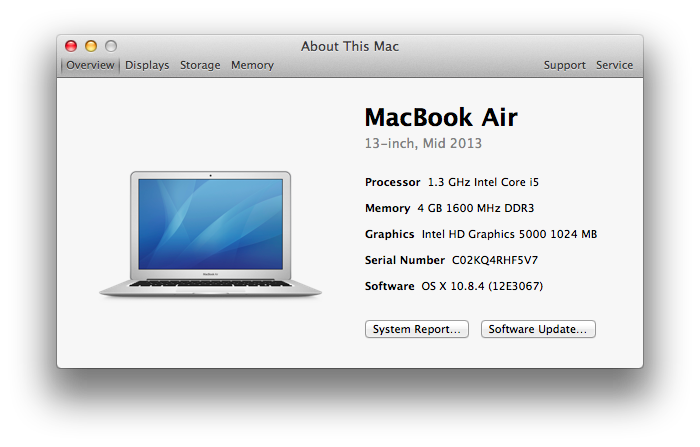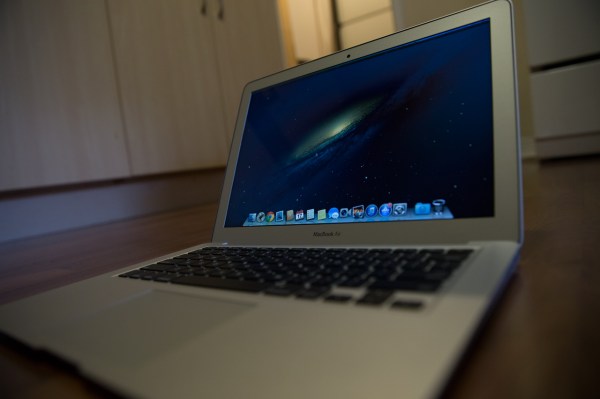The MacBook Air was the only new Apple hardware to be announced and launched at WWDC this year (besides the new AirPort Extreme), and while it isn’t a big change from the previous version, it packs some crucial improvements that really cater to the Air’s existing strengths. The 2013 Air is really Apple pushing the envelope with its ultraportable, and that has helped make one of the best computers in the world even better.
Basics (as tested)
- 1440 x 900, 13.3-inch display
- 128GB storage
- 1.3GHz dual-core Intel Core i5
- 4GB of RAM
- 0.11-0.68 inches thick, 2.96 lbs
- 802.11ac Wi-Fi
- 12 hours battery life
- $1,099
Pros
- MacBook Air portability/construction still amazing
- Next-gen Wi-Fi great for LAN transfers
- All-day battery life literally lets you forget the power cord at home
Cons
- Still no Retina display
- Could use more ports
Apple hasn’t changed the MacBook Air’s physical design since its last major update a few years ago, but the sleek, aluminum chassis isn’t showing its age. Sure, thinner computers have emerged (though the Air is still thinner at its tapered end) but the fact that PC form factors are really only just now catching up speaks volumes to the quality of the Air’s industrial design.
Apart from overall good looks, the Air has a tremendous leg up on most computers in terms of size, weight and portability. If you haven’t yet used one for any sustained period of time, you’ll be absolutely blown away. Going from the 13-inch MacBook Pro to the 13-inch Air is like leaving the past behind and joining the future; big leaps in computing design are seldom so observable, and so noticeable in terms of your daily usage.
A concern with many who aren’t familiar with the Air is that the thin and light chassis won’t be durable, but having used both the 11- and 13-inch as my daily working computer for months at a time, while jumping from desks to various remote working locations, I can attest to those fears being unsubstantiated. The Air may not feel quite as rock solid as the 13-inch Retina MacBook Pro, for instance, but it isn’t fragile by any means.
Apple has improved the Air in key areas with this redesign, and that’s where it makes sense to focus, based on the understanding that the previous version was already one of our favourite computers. Apple has focused on changes that should have the biggest impact, like the new Intel Haswell processors, the much speedier flash storage, a near doubling of battery life, and networking speeds that embrace 802.11ac, a tech on the verge of becoming conspicuous in consumer goods.
 Of these changes, the one with the greatest impact for the average user will be the new, all-day battery life afforded by the 12-hour capacity built-in pack (on the 13-inch Air; the 11-inch also gets a boost, but should afford you 9 hours, not 12). Apple is also testing battery life under more demanding conditions now, which suggests that if people go to extreme measures to conserve juice they might be able to get past that 12 hour mark. And indeed, I was able to eke out around 13 hours at least once, with screen brightness dialed down and other battery drains like Bluetooth disabled.
Of these changes, the one with the greatest impact for the average user will be the new, all-day battery life afforded by the 12-hour capacity built-in pack (on the 13-inch Air; the 11-inch also gets a boost, but should afford you 9 hours, not 12). Apple is also testing battery life under more demanding conditions now, which suggests that if people go to extreme measures to conserve juice they might be able to get past that 12 hour mark. And indeed, I was able to eke out around 13 hours at least once, with screen brightness dialed down and other battery drains like Bluetooth disabled.
The battery is truly remarkable. In standby mode, I haven’t yet even begun to scratch the surface of how long it can last after a week of usage. It really sips power when managing background tasks, and that should improve even further under OS X 10.9 Mavericks, which adds even more battery-conserving features to Apple’s desktop OS. The Air still ships with Mountain Lion, but you can bet Apple’s engineers were working on the upcoming OS X release when they were developing the new Air hardware.
Even without the extreme measures, this is a computer that you can forget is unplugged without fear of running into dire problems. If you’ve got a charge in the morning, and provided you aren’t doing anything too demanding that’s burning CPU cycles, you should have enough to get you through a reasonable mobile workday. Which is to say, we’re nearly at the point most people really badly want to be in terms of their MacBook’s battery life (short of limitless, endlessly clean and cool energy).
And the other upgrades help as well; the MacBook Air I reviewed was the 13-inch base model version, which retails for $1,099, but it come with double the internal storage standard vs. the 2012 model (128GB vs. 64GB), and Apple says that its new type of flash is a better performer, beating the previous generation’s storage performance speed by up to 45 percent. Certainly in testing the Air near-instantly recovered from sleep, and side-by-side with my top-end 2011 model, was snappier with nearly every task – likely also helped by the next-generation Intel Haswell processor.
Some nice new features on the MacBook Air that add to the computer in small ways are the addition of dual mics, which greatly improves call quality for things like FaceTime when you aren’t using headphones, and the new Intel HD Graphics 5000, which gives you around a 25 percent bump in performance over the Intel HD 4000 graphics chipset used in previous generations.
The other big new step-up in terms of features is the 802.11ac Wi-Fi networking card, which is complemented by the new AirPort Extreme router that offers the same. It’s a technology that’s becoming more and more commonly available on other routers, too, so it’s a very nice-to-have feature on the new Air, even if you can’t take advantage of it just yet. Still, in my brief tests with LAN performance over 802.11ac, I found that transfer times for files between computer and network-attached storage on the new router were just about halved vs. 802.11n speeds, though still lagged far behind wired Ethernet transfer times of course.
 The new MacBook Air isn’t a dramatic change, but it is a very good one. I’ve fallen in love with Apple’s Retina displays, so if I have one complaint about the computer it’s that there’s no ultra-high resolution display, but incorporating that kind of screen in this generation would’ve likely meant trading a big chunk of that new battery life away, and also increasing the price tag by around $400-500. For those who value the portability, flexibility and economy of the Air above all, the 2013 edition definitely hits all the right notes.
The new MacBook Air isn’t a dramatic change, but it is a very good one. I’ve fallen in love with Apple’s Retina displays, so if I have one complaint about the computer it’s that there’s no ultra-high resolution display, but incorporating that kind of screen in this generation would’ve likely meant trading a big chunk of that new battery life away, and also increasing the price tag by around $400-500. For those who value the portability, flexibility and economy of the Air above all, the 2013 edition definitely hits all the right notes.










